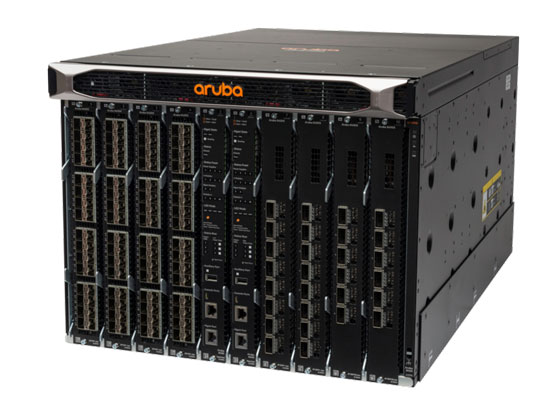Meet the Aruba 8400 Switch

Aruba 8400: Designed from the Ground Up for Automation and Network Insight
Looking at networking gear over the past several decades, not much has really changed from a high level. Okay, we’ve gotten bigger pipes to fit the much larger volume of data that needs to pass through them. We have added more protocols to manage the control plane, but a lot of the core technology is still pretty much the same.
OSPF, BGP, VRRP, etc … hasn’t really changed much. Sure, some of us are over spanning tree and aren’t wasting half of our links anymore, but the point is that many network engineers themselves haven’t changed how they deploy and manage solutions. Specifically, many of us are still managing our networks statically via the command line, troubleshooting after a problem has caused an outage, and not automating.
In the era of mobile, cloud, and IoT, this simply isn’t scalable anymore. If you’re a forward thinker, you may have already been using ansible, python, etc. for network automation, and it definitely helps when the vendor has designed a platform specifically for this. Gone are the days of screen scraping and expect scripting over SSH.
Aruba has been disrupting the networking industry for some time now in wireless and wired, but one thing missing from the product portfolio was an offering for the core… until now.
What’s New:
- High-performance Aruba core and aggregation switch with 19.2 Tbps switching capacity and carrier-class high availability.
- ArubaOS-CX automates using built-in REST APIs and Python scripts.
- Monitor and troubleshoot with Aruba Network Analytics Engine.
- High availability, virtualization and simplicity with Aruba VSX.
- High density, line rate 10GbE/40GbE/100GbE connectivity.
- Advanced Layer 2/3 feature set includes BGP, OSPF, VRF and IPv6.
Game-Changing Business Agility
The Aruba 8400 Switch Series is a core and aggregation switch solution with an innovative and powerful approach to dealing with the new applications, security and scalability demands of the mobile, cloud and IoT era.
Fully programmable with ArubaOS-CX, it brings automation and visibility and helps troubleshoot via simple scripting.
Aruba Network Analytics Engine provides the ability to monitor and troubleshoot the network, system, application and security related issues easily, through simple python agents and REST APIs.
High-availability, high-speed architecture with 19.2 Tbps switching capacity for always on networking.
Robust security and QoS with advanced Layer 2 and Layer 3 features including support for BGP, OSPF, VRF and IPv6.
Modern Software System Simplifies and Automates
The Aruba 8400 Switch Series is based on the new ArubaOS-CX, a modern software system for the core that automates and simplifies many critical and complex network tasks.
The built-in time series database enables customers and developers to develop software modules for historical troubleshooting, as well as analysis of historical trends, to predict and avoid future problems due to scale, security and performance bottlenecks.
Includes stability, independent monitoring and restart of individual software modules, and enhanced software process serviceability functions. And it allows individual software modules to be upgraded for higher availability; and supports enhanced serviceability functions.
Delivers enhanced fault tolerance and facilitates nearly continuous operation and zero-service disruption during planned or unplanned control-plane events.
High Performance and Carrier-Class High Availability
The Aruba 8400 Switch includes a high-speed, fully distributed architecture and provides up to 19.2 Tbps switching capacity to meet the demands and bandwidth-intensive applications today and in the future.
Aruba’s new high availability technology is Aruba VSX which has been designed from ground up to deliver the continuous availability, virtualization and simplicity requirements unique to the core of the network.
Resiliency and high availability with hot-swappable, redundant and load-sharing fabrics, management, fan assemblies and power supplies.
Scalable, compact 8U chassis delivers industry-leading line rate 10GbE/40GbE/100GbE port density, very low latency, and scalability ideal for the campus core.
So how is this any different from other chassis based switches?
ArubaOS-CX
Meet ArubaOS-CX, a modern network operating system. The entire state of the system is stored in a database, and all aspects of the system interact with it, and not directly with each other outside of it. This provides much greater modularity, extensibility, and allows seamless recovery when failures are detected. If one particular daemon crashes, it simply restarts and restores it’s state back from the database with almost zero downtime. This is huge! If you’ve ever had to recover a major process like OSPF and had to deal with the consequences, you know exactly what I’m talking about. Further, the system automatically generates a REST API for all objects in the data model, and can expose all features, functions, statistics…EVERYTHING to AOS-CX applications/services and to external systems if desired.
If that wasn’t enough, Aruba has also provided us with automated monitoring and troubleshooting via the network analytics engine. This allows IT professionals to easily monitor, detect problems, analyze trends, and immediately resolve issues instead of relying on traditional tools like SNMP and CLI after the fact. If a particular condition is detected, it is possible to automatically remediate via scripted actions.
Again, ArubaOS-CX is fully programmable via REST API, and for those of you who are ready to dig in, here’s a handy reference document to help get you started.
So are you ready to switch?(Pun intended)
Categories
Search
Blog Categories
Related Resources
Archives
- July 2024
- June 2024
- May 2024
- April 2024
- March 2024
- January 2024
- October 2023
- September 2023
- August 2023
- July 2023
- June 2023
- May 2023
- April 2023
- March 2023
- February 2023
- January 2023
- October 2022
- July 2022
- June 2022
- May 2022
- April 2022
- March 2022
- February 2022
- January 2022
- December 2021
- November 2021
- October 2021
- September 2021
- August 2021
- July 2021
- June 2021
- May 2021
- April 2021
- March 2021
- February 2021
- January 2021
- December 2020
- November 2020
- October 2020
- September 2020
- August 2020
- July 2020
- June 2020
- May 2020
- April 2020
- March 2020
- February 2020
- January 2020
- December 2019
- November 2019
- October 2019
- September 2019
- August 2019
- July 2019
- June 2019
- May 2019
- April 2019
- March 2019
- February 2019
- January 2019
- December 2018
- November 2018
- October 2018
- September 2018
- August 2018
- July 2018
- June 2018
- May 2018
- April 2018
- March 2018
- February 2018
- January 2018
- December 2017
- November 2017
- October 2017
- September 2017
- August 2017
- July 2017
- June 2017
- May 2017
- April 2017
- March 2017
- February 2017
- January 2017
- December 2016
- November 2016
- October 2016
- September 2016
- August 2016
- July 2016
- June 2016
- May 2016
- March 2016
- February 2016
- January 2016
- December 2015
- October 2015
- September 2015
- August 2015
- July 2015
- June 2015
- May 2015
- April 2015
- March 2015
- February 2015
- January 2014
- February 2013




